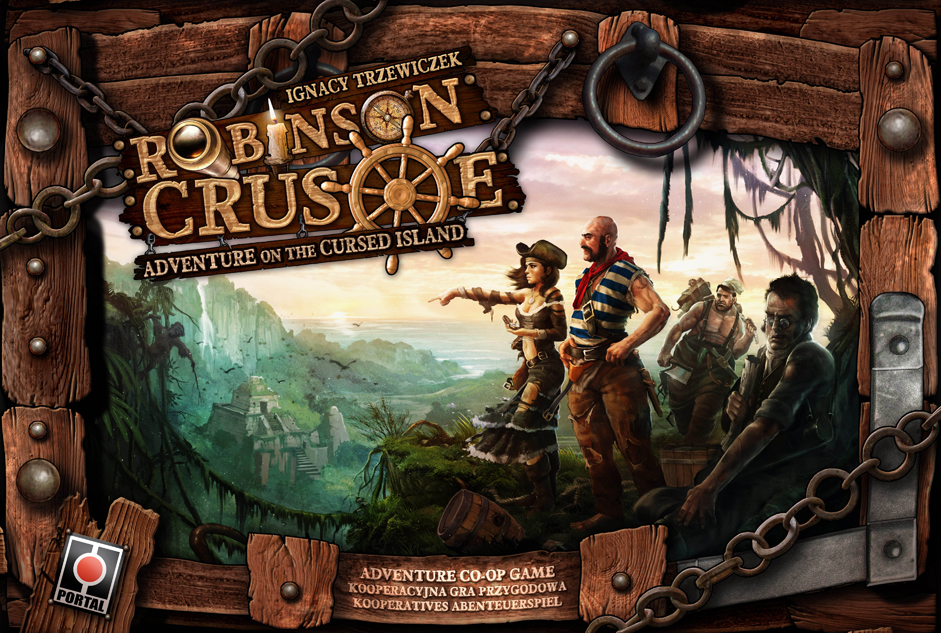A couple of years ago, while I was neck-deep into other board games, I kept reading praises about “the Robinson Crusoe board game”, and how wonderful it was. I was instantly intrigued, however, I procrastinated on picking it up. The game sold out worldwide, and was practically unavailable. I emphasize “practically”. Yes, you could score a copy of Robinson Crusoe on Ebay or other random site from time-to-time–at an exorbitant markup. This premium precluded me from buying it right away, and my interest in the game waned.
About a year later, a reprint was announced, and I pre-ordered the game immediately. Once it arrived and I lifted it out of the shipping box, I was a bit shocked at just how heavy the game was. Little did I know that the “heaviness was more than skin deep”.
Robinson Crusoe: Adventures on the Cursed Island is a euro-style cooperative board game where one-to-four players are stranded on an island, and must survive by accomplishing goals set forth on a scenario card. Players work together to explore unknown terrain, find and gather resources, uncover traps and treasures, build remedial technology, battle beasts, fend off bad weather, and fortify living quarters in hopes of creating a more habitable environment. The goal of the game is determined by a scenario card. Six scenario cards come with the game, and range in goals of pure survival, to exorcising cursed lands, escaping a volcano, rescuing a shipmate, fighting off native cannibals, or raising a family in the unknown.
Upon opening the box, I instantly focused on all of the component goodness, as well as the lack of any material storage solution. Plastic baggies were supplied with the game, but the sheer volume and variation of components practically begs for a storage canister, such as a small Plano box. Large chits, modular map tiles, various sizes and types of cards, resource cubes, dice, and wooden worker placement pawns fill the two-silo storage tray in the box. Although the components are quite numerous, the quality of the pieces are very acceptable. Dice feel heavy, cubes are brightly-colored, worker pawns are dense and vibrant, and card thickness is adequate.
The first thing I noticed about the game is the artwork, which carries a heavy shipwreck theme with tribal markings and aged parchment-look visuals, superimposed on a heavy woodgrain backdrop. The flow of the art style is carried over onto the basic-but-effective character cards, invention cards, and gameplay board. Right away, I could tell that a lot of thought and passion had been exercised in the design of the visuals, and it only aids in immersing the player.
The rulebook is a mixed bag. I have heard many complaints about the 18-page rulebook, and although it is not without its shortcomings, is not immensely daunting. The typeface is large and easy to read, every page contains full-color illustrations and gameplay examples, and emphasis on critical rules. Some of the rulebook structure could have been refined; however, I read through the rule book and immediately started my first game. Sure, I did have to reference the booklet a couple of times along the way, and even had to look online to solve a rule ambiguity. That being said, all-in-all I am quite happy with the ruleset and feel that most people who have successfully learned to play a medium-weight game should have little issue digesting the rule framework. One caveat–I highly suggest playing through a session alone to really feel out the flow of the turn phases before introducing new players. Once comfortable with the rules, actually explaining Robinson Crusoe to entering players is fairly simplistic.
The game board is split into three sections. About half of the board is devoted to the modular map tiles, where the terrain, resources, treasures, traps, and beasts will be discovered by the players. Another large section of the board illustrates what inventions can be built and the status of camp improvements. The lower portion of the board houses various decks of Action Cards devoted to divulging the (mis)adventures of the players as they attempt to build, gather, and explore. Other minor areas of the board house the morale track, and other worker placement tasks such as “arranging the camp” or rest.
Each player chooses an available character card from a selection of Carpenter, Cook, Explorer, or Soldier (Soldier can only be used in the 4-player variant). Each character card has inherent skills and a personal invention with which he/she can aid the team’s survival. Also available is Friday, the local native, and a dog. These are used primarily in low-player-count situations where the difficulty needs to be toned down. Each player chooses two worker placement tokens for action selection placement.
Fifteen inventions are placed on the board, for the players to create if they deem it necessary. Each one is dependent upon certain terrain availabilities before they can be created. A number of event cards equal to the number of rounds on the scenario card are randomly selected and placed on the board. There are quite a few event cards, so every game will be completely different.
A beginning island tile is placed, and if the scenario allows, starting “items” are randomly determined. These items could be anything—a can of biscuits, a pistol, and a bible are just a few. These are limited-use items, and should be saved until critically-needed.
Gameplay in Robinson Crusoe is extremely detailed, so I will forego infinite details, as there are many video walkthroughs available. Each “turn” is broken down into various “phases”, as follows:
- Event Phase
- Morale Phase
- Production Phase
- Action Phase
- Weather Phase
- Night Phase
- Event Phase – During the event phase, the top card of the Event deck is drawn and read to the group. This text usually involves some sort of hurdle that the group must circumvent. This could range from impromptu nasty weather, to roaming beasts, to drought, and even depression. The required card is placed at the bottom of the board where within a couple of turns, if the event is not addressed, severe repercussions are dealt.
- Morale Phase – Based on the morale of the group, Determination Tokens are either garnered or spent. Determination tokens allow players to exercise their character’s special abilities.
- Production Phase – Players receive resources such as food and/or wood based on where the camp is located on the map.
- Action Phase – The Action Phase is where the mass of the game takes place. During the Action Phase, players take turns placing their worker placement tokens on various areas of the board to take certain actions. These actions involve a range of options such as exploring unknown areas of the island in hopes of finding discoveries (such as deserted weapons, clothes, or a range of other helpful items) or additional land types, attempting to build an invention, gathering additional resources from other discovered areas of the island, and refining the camp by building and improving the roof, palisades, and weapon strength. Other selectable actions include heading off dire Event cards, arranging the camp (which increases morale level), and rest (to heal). In some instances, if 2 or more worker pawns are dedicated to a task, it is a complete success. In certain situations, multiple workers are required (such as hunting). For other tasks, success is determined by a roll of three dice to ascertain if the venture is successful, if the character is harmed during the task, and if an “adventure” is encountered. These Adventure Cards are quite unique—they are either good/bad and immediate effect, or of a risk-reward nature. In the latter example, a player might find a card yielding a windfall of bamboo which can be used to build many items. The downfall is that the card has to be shuffled into the Event Deck. If drawn during the course of the game, the second event transpires, which would illustrate that the wood was partially rotten and the roof strength of the players’ shelter must be reduced. This mechanic requires the player to weigh the inherent risks of taking advantage of certain imbued benefits.
Once all worker placement tokens have been placed, and action success determined, players remove their tokens until the next turn.
- Weather Phase – During the weather phase, players are required to measure the strength of the camp versus the severity of the storm (if any), and must discard wood and food in certain cases such as heavy rain or snow. In addition to the weather threat, there could be a threat of hungry animals. The weather and the hungry animals are determined by die throws, but usually only transpire during specific turns as outlined by the scenario card.
- Night Phase –During the night phase, players must eat by discarding food resources. All resources which the players are unable to discard yield a health decrease, and potentially a morale decrease as well. This phase is also when resting players heal.
Once the turn is over, the turn marker on the scenario card is moved forward one space. The game continues in this fashion until either a player dies (all players lose when one player is lost), the scenario turn timer is exceeded (resulting in a player loss), or all scenario goals are achieved. In my experience, an average turn lasts about 7-10 minutes, yielding a game of 1 to 2 ½ hours long, depending on the scenario and the quickness of the players.
Robinson Crusoe is one of the most thematic board games I have ever played. I have quite a number of plays in the books, and every session has turned out differently. The flavor text of the Adventure and Event cards tell a unique story in every game, as if the players were reading a novel or one of the “Choose Your Own Adventure” books from the 80’s. Critical decisions can make—or break—a game due to their pivotal nature, yielding post-game banter such as “if I had only succeeded killing that bear”, or “the gamble to use our resources to create the moat around the camp really paid off”. Recanting game events continually call me back to the game for additional sittings, and have compelled me to buy the Robinson Crusoe – Voyage of the Beagle campaign mega-expansion (which is a separate review in itself!). Just enough Euro-style gameplay mixed with various random elements yields an experience just about any gamer will appreciate.
Everything is not perfect with this game, however. As mentioned, some gamers who have yet to bite off a complex game might find the ruleset cumbersome. With Robinson Crusoe, reading the manual and learning the game can take a couple of sessions. But teaching the game is much easier—my non-gaming daughter learned to play in one session with some oversight. As well, game setup and game length may put some people off. Setup for the game takes me about 20 minutes. Also, game length can become quite protracted, if players are paralyzed by over-analysis of action selection.
Even with these detractions, Robinson Crusoe is one of my most prized board games, and its following and continual demand shows that many people share these same sentiments. Should I be marooned on a deserted island somewhere, and could only take along one board game, it is quite possible that Robinson Crusoe: Adventures on the Cursed Island would be my unanimous game of choice.







Great game!
this is wonderful game! i don’t understand why user score is so low.